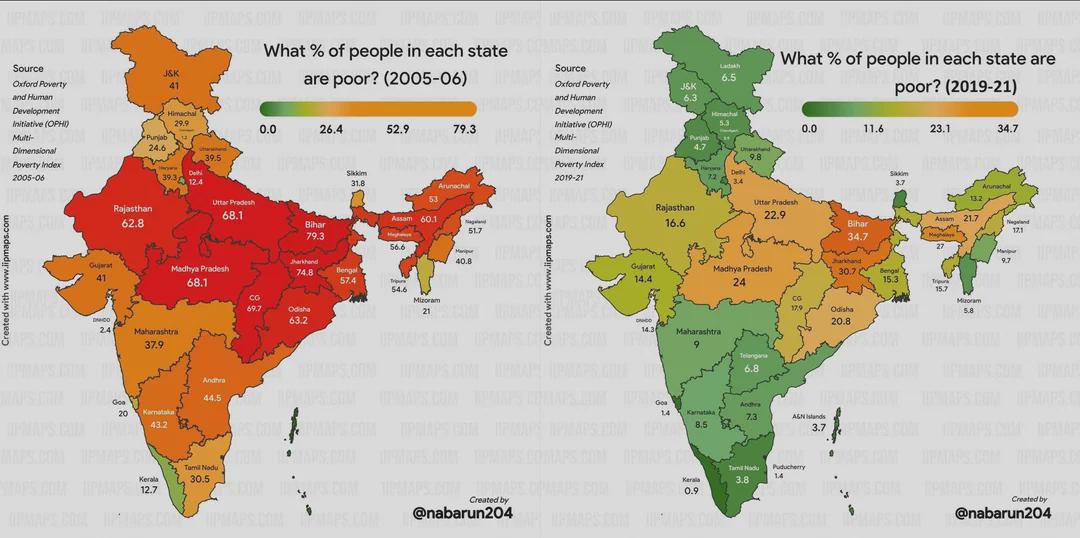Poverty Change in India Over 15 Years Map


David Chen
Data Visualization Specialist
David Chen is an expert in transforming complex geographic datasets into compelling visual narratives. He combines his background in computer science ...
Geographic Analysis
What This Map Shows
This map visualizes the changes in poverty levels across India over a span of 15 years. It highlights shifts in poverty rates in various states and union territories, offering a comprehensive overview of how economic conditions have evolved in the country. By focusing on the relative changes in poverty, we can better understand the socioeconomic landscape of India and the effectiveness of policies aimed at alleviating poverty.
Deep Dive into Poverty in India
Poverty remains one of the most pressing challenges facing India, a nation with a population exceeding 1.4 billion people. As of the latest data, nearly 364 million individuals live below the poverty line, which is defined as earning less than $1.90 a day. However, the map showcases a significant transformation in poverty levels across different regions from 2005 to 2020. Interestingly, while some areas have made remarkable progress in reducing poverty, others continue to struggle.
The factors influencing these changes are multifaceted. Economic growth, access to education, healthcare, and employment opportunities are crucial to understanding these dynamics. For example, states like Gujarat and Maharashtra have seen substantial improvements in poverty reduction, primarily due to industrialization and urban development. The rise of the service sector and investment in infrastructure have played vital roles in creating jobs and uplifting communities.
Conversely, states such as Bihar and Uttar Pradesh, despite being populous, have lagged in poverty alleviation. High population density, lack of access to quality education, and limited job opportunities have hampered progress. In fact, Bihar has one of the highest poverty rates in India, reflecting the challenges of rural development and infrastructural deficits.
What’s fascinating is that regional variations contribute to the complexity of poverty in India. For instance, while southern states like Kerala and Tamil Nadu have managed to implement effective welfare programs and achieve higher literacy rates, northern states face significant hurdles due to political instability and socio-economic disparities.
Moreover, the COVID-19 pandemic has exacerbated the situation, pushing millions back into poverty due to job losses and economic downturns. The impact of this global crisis on poverty levels in India will be crucial to monitor in the coming years, as it challenges previously established trends.
Regional Analysis
Analyzing the map reveals stark contrasts across various regions in India. The southern states, including Kerala and Andhra Pradesh, have seen notable declines in poverty levels. Kerala, for instance, has invested heavily in education and healthcare, resulting in a well-rounded human development index. By 2020, poverty rates in Kerala were significantly lower compared to the national average, showcasing the effectiveness of its social policies.
In contrast, the northern states, particularly Bihar and Jharkhand, illustrate a different narrative. Despite some initiatives aimed at poverty reduction, these regions often struggle with inadequate infrastructure, agricultural dependency, and limited access to education. According to recent statistics, Bihar's poverty rate stands at approximately 30%, highlighting the urgent need for targeted interventions.
Furthermore, western states such as Gujarat have shown a remarkable decrease in poverty, attributed to their robust economic policies and a focus on industrial growth. The state has leveraged its geographical advantages to attract investment, creating job opportunities that have uplifted many from poverty.
Significance and Impact
Understanding poverty dynamics in India is crucial not only for policymakers but also for the global community. The implications of poverty extend beyond economic metrics; they influence health, education, and overall quality of life. Addressing poverty is vital for achieving sustainable development goals and fostering inclusive growth. Moreover, as India continues to emerge as a global economic player, its ability to manage poverty will significantly impact its stability and development trajectory.
Looking ahead, projections indicate that while some regions may continue to improve, challenges remain, particularly for states grappling with demographic pressures and economic disparities. The need for effective policies that address both urban and rural poverty is more critical than ever. Have you ever considered how poverty reduction strategies could shape the future of a nation? The road ahead requires innovative solutions, collaboration, and a commitment to uplifting the most vulnerable.
Visualization Details
- Published
- August 15, 2025
- Views
- 226
Comments
Loading comments...